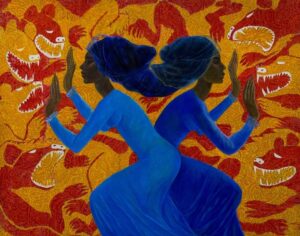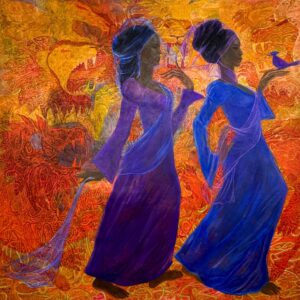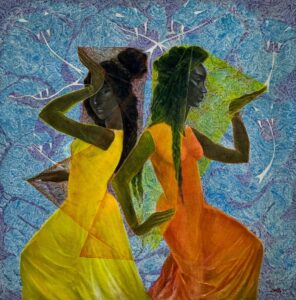
Bisrat creates a dynamic tension, the quiet strength of her figures against the fierce energy of the background. It’s as if the figures are carrying forward despite everything, embodying a sense of endurance and transcendence. This juxtaposition, where the figures appear in harmony amidst chaos, captures the essence of survival and grace, showing us a pathway through the fire and inviting us to find our own strength in the face of life’s challenges.
Dagim Abebe on the work of Bisrat Shibabaw
Now I can see Bisrat Shibabaw; the visionary artist
The opening of Bisrat Shibabaw’s solo exhibition at Moa Anbessa art studio gallery in the heart of Kazanchis is a momentous occasion, holding deep personal significance for nearly every artist and art enthusiast across Addis Ababa. Known for her vibrant and evocative style, Bisrat’s artwork has become a rare sight in local exhibitions, making this showcase an especially unique and cherished experience for the art community.
Bisrat’s connection to this neighborhood, where she was born in 1965 and raised, infuses her exhibition with an added layer of intimacy, as its set against the vibrant backdrop of Kazanchis, a district long recognized as a cultural hub where music, dance, and the arts have thrived for generations. The gallery at Moa Anbessa art studio gallery is more than just a venue; it’s a bridge connecting her creative journey with her roots, fostering a shared sense of history and kinship. It’s a place that evokes powerful memories, where the rhythm of the city mingles with the spirit of art.
In a recent gathering at his space, Moa Anbessa art studio gallery, Merid Tafesse spoke passionately about this connection, reminiscing about Kazanchis as a cradle for creativity and community. His words underscored how deeply the neighborhood is woven into the collective memory of Addis Ababa’s art community, a place that has shaped lives, careers, and friendships over the years. For Bisrat, returning to Kazanchis with her art feels personal, an exchange between her life’s work and the very streets that nurtured her passion.
This exhibition becomes more than an artistic display; it’s a reunion, a space for reflection and dialogue where personal history and public memory converge. For those of us in the art community, Bisrat’s work resonates as a reminder of our interconnected paths, shaped by shared spaces and stories. The exhibition stands as a testament to Kazanchis’ enduring role as a center for cultural expression, and Bisrat’s vibrant pieces serve as both a tribute to and a celebration of this neighborhood’s creative spirit, which seems perfect timing since the neighborhood is rapidly changing due to “redevelopment” of the city.
Recently, Bisrat Shibabaw’s work has become a rare sight in the Addis Ababa art scene, making this exhibition a unique opportunity to reconnect with her powerful vision. Her collections invite us to delve deeply into her inner explorations and her strong reflections on our shared existence, bridging the personal and collective. The Moa Anbessa art Studio gallery has opened its doors to bring this experience to life, allowing us to engage with Bisrat’s work at a moment that feels perfectly aligned for everyone in the community.
This exhibition is more than just an unveiling of her pieces; it’s a rare convergence of past and present. Alongside her newest works, we have the opportunity to see historical pieces from her time studying in Russia, in Saint Petersburg Academy of Arts; a foundational period that helped shapes her artistic journey with its huge expositor to its surrounding of Art Museums. These earlier works reflect a pivotal stage in her development, and, when displayed together with her recent collections, they offer an immersive look at the evolution of her voice as an artist. It’s a journey through her reflections on memory, cultural identity, and the universal themes that define our shared human experience.
Through this thoughtfully curated exhibition, Moa Ambesa Studio has created a platform for us to stand in a collective memory, connected to Bisrat’s work in a way that transcends time and space. For the Addis Ababa art community, this is more than an exhibition; it’s a reconnection with an artist whose work challenges, inspires, and moves us, set against the historic and culturally rich backdrop of Kazanchis.
The exhibition began the moment I stepped through the entrance gate, and there she was Bisrat Shibabaw, dressed in a beautifully crafted traditional Ethiopian dress. Her presence in this attire was a powerful reflection of her connection to our shared heritage, grounding the event in a sense of cultural pride and authenticity. The scene felt almost cinematic, and the air was filled with classical music that added a layer of depth to the moment. It’s hard for me to imagine Bisrat’s presence without this music; it seems to echo the rhythm of her creative spirit, weaving together the themes of her work with the elegance and gravity of each note.
This carefully curated setting captured everything I’d come to expect from her exhibitions, an invitation to not just view art, but to experience it as a living, breathing reflection of her soul and ours. The music wasn’t just background; it was part of the artwork itself, enhancing each piece and creating an atmosphere where her reflections on memory, culture, and existence resonated deeply. Each detail felt intentional, from her choice of dress to the music, allowing me and everyone present to feel connected to her journey and the cultural roots that shape her work.
As I left Bisrat on the balcony, surrounded by familiar faces, I felt an urgency to step fully into the exhibition room, letting my whole mind and body immerse in her work, as if becoming part of it. The first pieces in her collection greeted me with a 14 vibrant, experimental array of artworks on paper, some textured with collage, and others layered with intricate details. These works drew everyone in, each piece infused with an energy that seemed to echo her journey.
What struck me immediately was the way the vibrant blue background blended seamlessly with the artwork itself, erasing any boundary between the space and her creations. This blue felt like an invitation, a vast and boundless sky, symbolic of Bisrat’s journey through life and art. It gave the sense that her story was unfolding all around us, an endless journey woven into each piece, allowing us to travel with her through the layers of her memories and artistic evolution.
Her lifetime’s work came alive in this exhibition, from the delicate 12 sketches and drawings she created during her studies at the Academy in Saint Petersburg to the powerful 6 oil paintings on canvas, each one brimming with figures that seemed to tell their own stories. As I stood in front of a particularly striking canvas, Dr. Desta Meghoo the curator appeared quietly from the other side of the room, leaning in to whisper, ‘The most important is the background, as Bisrat said.’ Her words lingered in my mind, guiding me to see each background as an integral part of the narrative, a layer of storytelling that gave life to the figures and set the tone for each piece.

With this insight, I felt compelled to linger, reading each painting as though it were a storybook. The backgrounds became landscapes of emotion and history, each brushstroke revealing something deeper. Moving slowly, I took in every detail, allowing myself to be swept up in Bisrat’s world, each piece an open doorway into the essence of her life’s work and vision.
What continues to captivate me as an artist and as Bisrat’s mentee is the sheer power of her backgrounds. They seem to carry a raw, unfiltered voice, resonating with patterns and haunting animal forms that hover throughout the space, like specters of our daily realities and untold stories. The fire woven into these backgrounds gives the sense of an intense, unrelenting world, a world where danger and beauty collide; mirroring the struggles, conflicts, and truths we witness and hear about every day. The intensity in her backgrounds doesn’t just set a scene; it demands our attention, pulling us into the layers of meaning within her work.

Yet, amid this fiery expanse, her carefully arranged figures in the foreground remain strikingly calm. Balanced in their muted, harmonious colors, these figures move through the scene as if untouched by the turmoil around them. They’re almost ghostly in their detachment, peacefully gliding through the chaos, as if in a dance. This contrast is powerful: while the background blazes with tension, the figures seem to embody resilience, strength, and perhaps even hope. They appear unfazed by the flames and the wildness that surrounds them, as though symbolizing an inner peace or fortitude that cannot be shaken.
Through this masterful contrast, Bisrat creates a dynamic tension, the quiet strength of her figures against the fierce energy of the background. It’s as if the figures are carrying forward despite everything, embodying a sense of endurance and transcendence. This juxtaposition, where the figures appear in harmony amidst chaos, captures the essence of survival and grace, showing us a pathway through the fire and inviting us to find our own strength in the face of life’s challenges.

